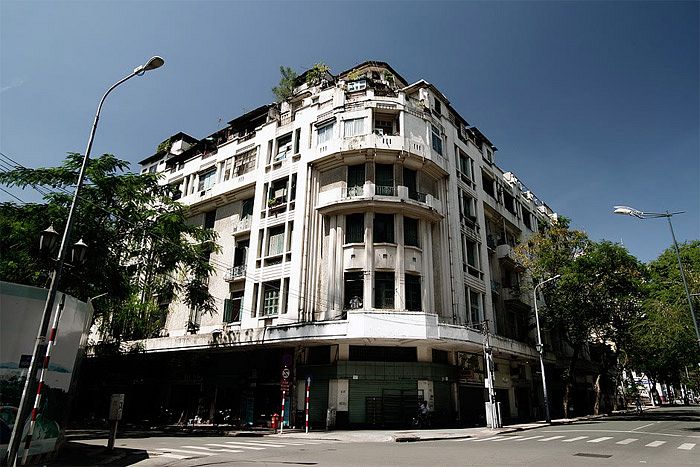The proposal to build a 14-storey City Administration Centre behind the Hồ Chí Minh City People’s Committee building promises yet again to transform the skyline of the city’s central business district. Tim Doling takes a last look at two of the existing buildings on that block which will soon be consigned to history.
Many of us pass it every day and scarcely give it a second look. Yet the building which houses the Hồ Chí Minh City Department of Information was once a focus of French colonial power second only to the Governor’s palace.
The first French government building on this site was the Direction de l'Intérieur (Department of the Interior), constructed by the Cochinchina authorities in the early 1860s. Although no photographs of the building have survived, it was depicted clearly in the remarkable 1881 engraving Saïgon d'après nature.

The earlier Direction de l’Intérieur as depicted in the 1881 engraving, Saïgon d’après nature.
According to L de Coincy’s book Quelques mots sur la Cochinchine en 1866 (A Few words about the colony in 1866), the department was “responsible for the entire civil, judicial and financial administration of the colony” and its representatives throughout Cochinchina were inspectors of Indigenous Affairs.
By 1888, the functions of the Direction de l'Intérieur had been subsumed by the Secrétariat général du gouvernement de la Cochinchine, and a larger building – the current one – had been constructed at 59-61 rue de la Grandière. By the early 20th century, this was also known by the alternative names of Bureaux du gouvernment or Bureaux des Services civiles.

The current compound as it appears on the 1890 map of Saigon.

The compound in the early 20th century.
Following the Second World War, the French briefly set up a Ministère de l’Intérieur (Interior Ministry) in the compound for the ill-fated

In the late 1940s the compound briefly served as the Interior Ministry of the State of Việt Nam.
In 1958 the compound made a fleeting appearance in Joseph L Mankiewicz’s film version of Graham Greene’s novel The Quiet American.
Today the 126-year-old compound currently serves as the Hồ Chí Minh City Department of Information and Communications (Sở Thông tin và Truyền thông Thành phố Hồ Chí Minh, www.ict-hcm.gov.vn).
Another casualty of the proposed redevelopment will be the attractive art deco office and apartment block at 213 Đồng Khởi.

213 rue Catinat, pictured soon after it opened.
For the first 60 years of colonial rule, the office of the Secrétaire général stood on this spot, but in the late 1920s that was demolished and replaced by 213 rue Catinat, in its day one of the most prestigious addresses in the city.
Built in 1929-1930 by the Société d'exploitation des établissements

The main entrance of 213 Đồng Khởi. Photo by Tim Doling.
However, most of the building was occupied by apartments. One of its best-known former residents was rubber baroness Madame Janie-Marie Marguerite Bertin Rivière de la Souchère, who rented an apartment here from 1932 to 1938 after losing her magnificent estate in the Great Depression.
The building at 213 rue Catinat is also mentioned in Graham Greene’s novel The Quiet American – after the departure of his girlfriend Phương, Fowler briefly considers finding a new place to live and goes there to view “the pied-a-terre of a rubber planter who was going home”. However, Graham Greene clearly disliked the building, since Fowler refers to it disparagingly as a “so-called modern building (Paris Exhibition 1934?) up at the other end of rue Catinat beyond the Continental Hotel.”
Sadly, despite their age and historic value, neither 59-61 Lý Tự Trọng nor 213 Đồng Khởi are currently recognised as national or city heritage.
Tim Doling is the author of the forthcoming book of walking tours entitled Exploring Hồ Chí Minh City (Nhà Xuất Bản Thế Giới, Hà Nội, 2014) and also conducts 4-hour Heritage














